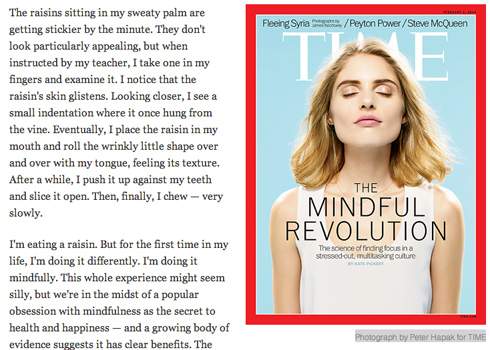TIME subscribers are looking at the article now, but the issue itself won’t hit newsstands until Monday. In the meantime here’s a deeper look and some further reading on the people and practices mentioned in “The Mindful Revolution.”
Kate Pickert, writing for TIME, notes that “We’re in the midst of a popular obsession with mindfulness as the secret to health and happiness—and a growing body of evidence suggests it has clear benefits.” Pickert takes a Mindfulness-Based Stress Reduction course to write the article, and talks about how the course was developed back in 1979 by Jon Kabat-Zinn. The current issue of Mindful features Kabat-Zinn and his pioneering mindfulness work, including his thoughts on the present and future of mindfulness.
“There are tremendous benefits that arise from mindfulness practice, but it works precisely because we don’t try to attain benefit,” says Kabat-Zinn. “Instead, we befriend ourselves as we are. We learn how to drop in on ourselves, visit, and hang out in awareness.”
Pickert points out that calling mindfulness the “latest self-help fad” totally ignores how the practice is gaining acceptance among those who would otherwise considered meditation a bit flaky: Silicon Valley enrepreneurs, Pentagon chiefs, FORTUNE 500 titans, among others.
That’s something we’ve seen in our year of publishing Mindful, too. Our June 2013 issue featured Congressman Tim Ryan (D-Ohio), author of A Mindful Nation talking about bringing mindfulness into politics and society. Eileen Fisher talked to Mindful about why kindness and collaboration are king in her business. “I have a deep sense that I didn’t create this business alone,” she says in Mindful‘s December issue. “I listened, I heard, and we worked together. Working in a collaborative way made it so much better.”
Even police officers are seeing the benefits of having a mindfulness practice. Lieutenant Richard Goerling of the Hillsboro Police Department brought a mindfulness training program to his department after they had “hit rock bottom,” as journalist Maureen O’Hagan reported in Mindful‘s October issue. O’Hagan points to an incident involving a veteran officer who faced off against the rest of the police force in January 2013. It left the team shaken, and the current police chief dedicated to finding new approaches to supporting the men and women in the department.
And with the constant surge of new apps, social media, and digital-device-distraction, Silicon Valley has a lot to say about mindfully navigating technology. Read “A User’s Guide to Living Well in Screenworld” from the August issue of Mindful, where three tech insiders talk about making digital technology work for us—not the other way around. (If you’re looking to mindfully navigate your tech, check out our infographic on how to take control of your tech.) And if you’re looking to download some mindfulness to your phone, you’ll want to check out our mindful apps review—all apps mentioned are available from iOs and Android devices.
Pickert talks about the kinds of people in her MBSR class, and what they’re hoping to gain from meditation. The response of one mother resonated with us and with Mindful‘s August feature on mindfulness and parenting: a mother wanting to be more present with her child. Take a peek at how we covered Nancy Bardecke’s Mindfulness-Based Childbirth and Parenting course and what parents learned. If you’re looking for more than just a peek, check out our Q & A with Amy Saltzman, author of A Still Quiet Place, about how children and teens can find awareness, her research with children, and some key practices for caregivers. In Mindful‘s December issue, psychologist Stefanie Goldstein shares three tips for creating a mindful family.
One of the reasons mindfulness has become so popular is the growing research around its benefits and how science is learning about our brains’ ability to rewire itself. Our science columnist Sharon Begley tackles neuroplasticity in “Rewiring Your Emotions,” and speaks with neurobiologist Richard Davidson at the University of Wisconsin on his pionnering work in the field. In “Collisions of Creativity,” Begley looks at how psychologists and neuroscientists are trying to understand how we generate new ideas, and debunks three popular ideas we have about where original ideas come from in our brains.
In the business realm, Pickert says, high stress created around the 2008 meltdown didn’t seem to abate. Pickert mentions Janice Marturano as one of the pioneers in mindfulness and leadership, noting her well-attended training session at Davos in 2013 and her new book, Finding the Space to Lead. Here on Mindful.org, you can visit Marturano’s blog about mindful leadership. She also appears regularly in Mindful magazine’s “At Work” column, answering questions about mindfulness and work life.
Pickert begins her article with a basic mindfulness practice involving paying attention to a raisin, and moves on to seated meditation practice and walking meditation. If you’re interested in trying out mindfulness practice on and off the cushion, visit our practice page (no raisins necessary for these ones). For more on the people and practices surrounding mindfulness, check out Mindful magazine here on Mindful.org.
This downloadable .pdf collection from Mindful magazine will take you deeper into the mindful revolution—to meet the people and try the techniques—from feature stories on Congressman Tim Ryan and mindfulness pioneer Jon Kabat-Zinn to mindfulness practices for the workplace and every day.








